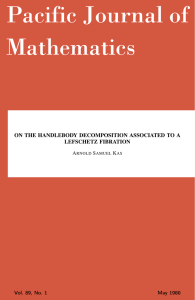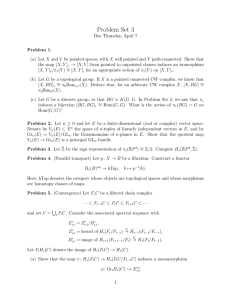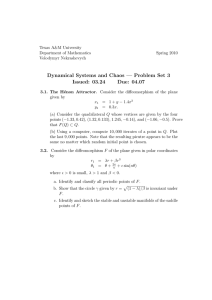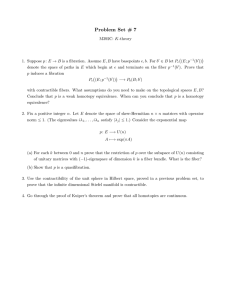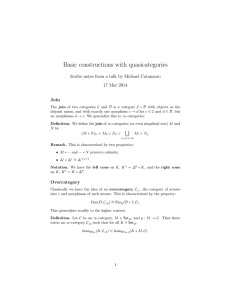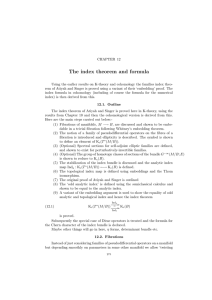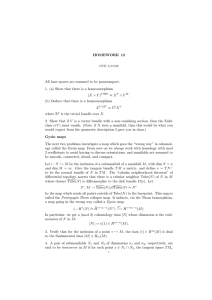on the handlebody decomposition associated to a lefschetz fibration
advertisement
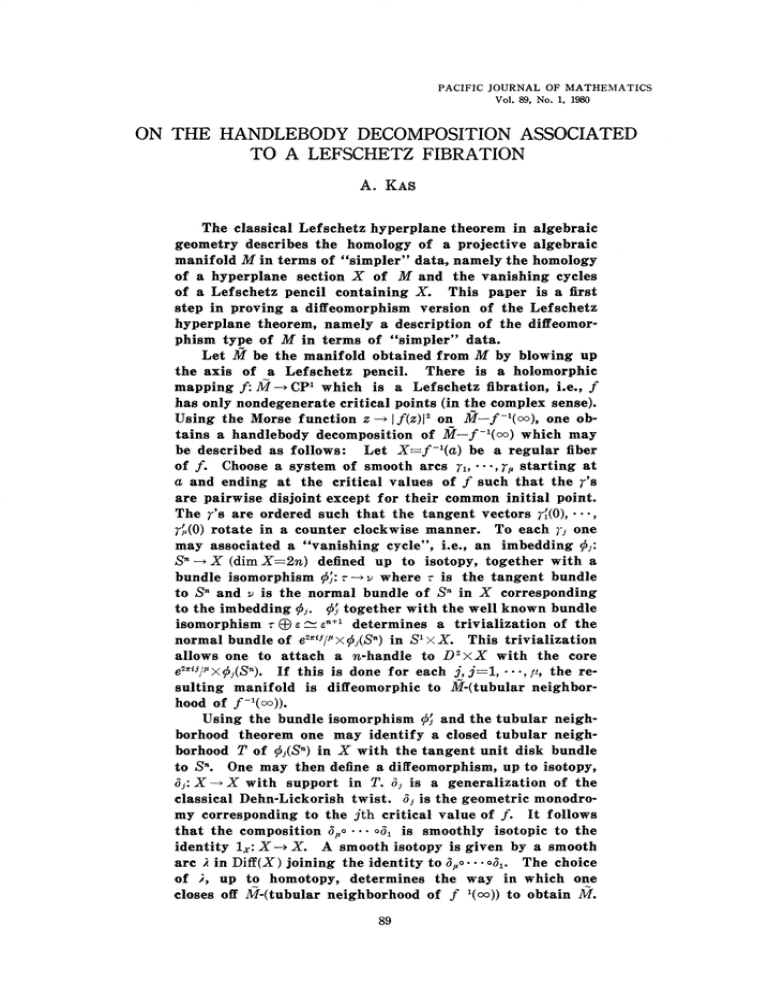
PACIFIC JOURNAL OF MATHEMATICS
Vol. 89, No. 1, 1980
ON THE HANDLEBODY DECOMPOSITION ASSOCIATED
TO A LEFSCHETZ FIBRATION
A. KAS
The classical Lef schetz hyperplane theorem in algebraic
geometry describes the homology of a protective algebraic
manifold M in terms of "simpler" data, namely the homology
of a hyperplane section X of M and the vanishing cycles
of a Lef schetz pencil containing X. This paper is a first
step in proving a diffeomorphism version of the Lefschetz
hyperplane theorem, namely a description of the diffeomorphism type of M in terms of "simpler" data.
Let M be the manifold obtained from M by blowing up
the axis of a Lefschetz pencil. There is a holomorphic
mapping f:M—>CP* which is a Lefschetz fibration, i.e., /
has only nondegenerate critical points (in the complex sense).
Using the Morse function z->\f(z)\2 on M—f'H00)* one obtains a handlebody decomposition of M—/"H00) which may
be described as follows: Let X—f'^a) be a regular fiber
of /. Choose a system of smooth arcs γlt
, γμ starting at
a and ending at the critical values of / such that the γ'β
are pairwise disjoint except for their common initial point.
The γ'β are ordered such that the tangent vectors fί(0), • •,
γμ(0) rotate in a counter clockwise manner. To each γj one
may associated a "vanishing cycle 9 ', i.e., an imbedding φr.
Sn —> X (dim X—2n) defined up to isotopy, together with a
bundle isomorphism φ)\τ->v where τ is the tangent bundle
to Sn and v is the normal bundle of Sn in X corresponding
to the imbedding φj. φj together with the well known bundle
isomorphism r φ ε ^ ε n + 1 determines a trivialization of the
2icij μ
n
normal bundle of e l xφj(S ) in S*xX. This trivialization
2
allows one to attach a w-handle to D xX with the core
2πij μ
n
e l xφj(S ).
If this is done for each j,j=l,
•••,/<, the resulting manifold is diffeomorphic to M-(tubular neighborhood of /"Hoo)).
Using the bundle isomorphism φj and the tubular neighborhood theorem one may identify a closed tubular neighborhood T of φj(Sn) in X with the tangent unit disk bundle
to Sn. One may then define a diffeomorphism, up to isotopy,
δji X —• X with support in T. δj is a generalization of the
classical Dehn-Lickorish twist, δj is the geometric monodromy corresponding to the jth critical value of /. It follows
that the composition δμ°
°o1 is smoothly isotopic to the
identity 1X:X-+X.
A smooth isotopy is given by a smooth
arc / in Diff(X) joining the identity to δμo-- oδλ. The choice
of /, up to homotopy, determines the way in which one
closes off M-(tubular neighborhood of / H00)) to obtain M.
89
90
A. KAS
Thus the diffeomorphism type of M is determined by the
invariants φltφί, -",φμ,φμ and {λ}, the homotopy class of L
Conversely, given a compact oriented 2n dimensional manin
fold X, imbeddings φj\S ->X1 j=l, •••, μ, and bundle isoO(5
s
morphisms φjiτ^vj
such that <V'* i i smoothly isotopic
to lχ, and a homotopy class {λ\ of arcs in Diff(X) with
O(5
initial point l x and end point <V*
i, one may construct a
2n+2 dimensional manifold M and a Lefschetz fibration
1
f:M—» CP . It is shown that in the case n—1, apart from
certain exceptions, M is uniquely determined by φlf
, φμ>
i.e., the bundle isomorphisms φ[, " ,φμ and the smooth isotopy class {λ} are superfluous.
0. Introduction. The classical Lefschetz hyperplane theorem
in algebraic geometry describes the homology groups of an algebraic manifold M in terms of those of a hyperplane section X and
in terms of the "vanishing cycles" of X. This paper was inspired
by the Morse theoretic proof of the Lefschetz hyperplane theorem
due to Andreotti and Frankel [1]. Their approach is to blow up the
base locus of a generic Lefschetz pencil so as to obtain a manifold
M and a "Lefschetz fibration" /: M -> P\C).
They then use the
Morse function |/| 2 to describe M, at least up to homotopy type,
and finally they show how to relate the homology groups of M to
those of M. Now according to Smale's handlebody theory [11], it
should be possible to use the Morse function |/| 2 to determine the
full diffeomorphism class of M, not just its homotopy type. In
order to do this we must describe the framings of the imbedded
spheres (vanishing cycles) corresponding to the critical points of
I/I2. In general, the framing associated to a critical point of index
n + 1, has an ambiguity measured by πn(S0(n + 1)). In our situation, we can improve this to πn(S0(ri)). This completely determines
the framing in certain cases, most notably if JbΓ is a complex surface.
In this paper, we describe a set of invariants associated to a
Lefschetz fibration /: Λf —> P\ which allows one, in principle, to give
a handlebody decompositions of certain complex surfaces.
There is a certain amount of overlap between some of the ideas
of this paper and certain papers of B. Moishezon and R. Mandelbaum
(cf. e.g., [6], [7], [10]).
1* The framings associated with a Lefschetz fibration* Let
M be a smooth manifold of dimension ^ 2 and let f:M—>S2 be a
smooth mapping. A point peM will be called a critical point of /
if the differential dfp: T(M)P -> T(S2)f{p) is not surjective. Now let
M be a closed compact oriented smooth manifold of even dimension,
ON THE HANDLEBODY DECOMPOSITION
91
say dim M = 2n + 2, n ;> 0, and assume that f: M-> S2 is a surjective mapping with a finite number of critical points. We will
identify S2 with the extended complex plane C(J°°. If z€S2 is a
regular value of / , then /"^(sO is called a regular fiber of / . It is
clear that up to diffeomorphism, the regular fibers of / are independent of the regular value z.
The smooth mapping f:M~>S2 will be called
a Lefschetz fibration if each critical point p of f admits a coordinate
neighborhood with complex valued coordinates (wlf
, wΛ+1), consistent with the given orientation of M, and if f(p) has a coordinate
neighborhood with a complex coordinate z, consistent with the
orientation of S2, such that locally, / has the form:
DEFINITION 1.1.
f(w) = z0 + w\Λ
DEFINITION 1.2.
Two Lefschetz fibrations
UM
> S 2 , a n d f2:M
> S2
are said to be equivalent, if / 2 = flr°/i where g is an orientation
preserving diffeomorphism of S2.
Let X denote any regular fiber of the Lefschetz fibration
f:M~->S2.
Notice that up to diffeomorphism, X only depends on
the equivalence class of the Lefschetz fibration f:M-^S2.
Notice
also, that X has a unique orientation consistent with the orientations of M and S2.
We wish to describe a handlebody decomposition of M associated
to the Lefschetz fibration f:M-*S2.
We will assume that a handlebody decomposition of X is already known.
We first recall some standard facts about handles and handlebodies. Let JV be a manifold with boundary and let n •= dim N.
Let
Φ:Sk-ιxDn~k
>dN
be a smooth imbedding. Form the union Nτ= N\JΦDkxDn-k where
we identify each point of S1*-1 x Dn-kczd(Dk x Dn~k) with its image
under Φ. JVΊ is a manifold with boundary and corner points. Let
V denote the unique manifold (possibly with boundary) obtained
from Nt by "straightening the corners" of Nλ (cf. [2]).
DEFINITION 1.3.
V is called: the manifold obtained from N by
attaching a &-handle along Φ.
It is easy to see that, up to diffeomorphism, V depends only
on the smooth isotopy class of Φ. Let Φo denote the restriction of
92
A. KAS
Φ to JS*""1 XO.
It follows easily from the tubular neighborhood
theorem [9], that Φ is determined, up to smooth isotopy, by a
bundle isomorphism:
where en~k is the trivial n — k bundle on Sh~\ and v is the normal
bundle of S*"1 in dN under the imbedding Φo. Thus the isotopy
class of the imbedding Φ is determined by:
( i ) A smooth isotopy class of imbeddings
Φo: S"-1
> dN
(ii) For each Φo in (i), a smooth isotopy class of bundle isomorphisms:
Notice that (i) is a "knot invariant". As for (ii), the distinct
bundle isomorphisms, up to smooth isotopy, are classified by the
group πk^(S0(n — k)). Φr is called a framing of Φo.
Let F:M~>R
be a Morse function, and let ceR be a critical
value such that F~\c) contains a single critical point p, where F
has index λ at p.
For each real number aeR,
let Ma =
{xeM\F(x) ^ a}. Then for ε > 0 sufficiently small, Mc+ε is diffeomorphic to the manifold obtained from Me-S by attaching a λ-handle
along Φ: Sλ~ι x Dn~λ —> dMc-ζ. To construct Φ explicitely, one may
choose (by Morse's lemma) a system of coordinates x19 ---,xn in M
centered at p, such that F(xu
, xn) — c — x\ —
— x\ + x\+ι + •
+ xl (cf. e.g., [8]). Then if ξ - (ςl9
, ξλ)eSλ-\ V = (%+i,
, V.) e
Dnλy
Φ: S*-1 x Dn~λ - > F~\c - ε) is defined by setting
where
(El,
Similarly, if F~\c) contains several nondegenerate critical points
Pi, '' ,pμ of indices λ1? * ,λ Λ , then Mc+ε is diffeomorphic to the
manifold obtained from Mc-Z by attaching μ handles, where the j t h
handle is a λ r handle attached along Φά: Sλ'-ιxD*-λ*->
F\c — έ),
3 = 1,
, μ, and where the images of the Φά are disjoint.
DEFINITION 1.4.
A handlebody decomposition of a manifold M
is given by:
( i ) a sequence M = MN Z)
z> Mo, where each Λfy is a sub-
ON THE HANDLEBODY DECOMPOSITION
manifold of M;
(ϋ) diffeomorphisms Φ,
* —> 3Mk,
>Mj U
93
and
x
Φj
i x D*~*i ,
>
A Morse function F: Λf —> R together with a gradient-like vector
field for Ff determine a handlebody decomposition of M (cf. [6]).
Now let /: M —> S2 be a Lef schetz fibration with regular fiber
X, where dim X = 2n, dim M = 2n + 2. We will assume t h a t 0 and
00 are regular values of /. Define F: M->R\J °° by F(p) = |/(p)| 2 .
Then it is easy to verify t h a t outside of / i O j U / " ^ ) , i*7 has only
nondegenerate critical points, each of index n + 1 (cf. [1]).
1.5. The Lef schetz fibration f:M->S2
is said to be
normalized if the critical values of / are precisely the μ roots of
unity.
Every Lef schetz fibration is equivalent to a normalized Lef schetz
fibration.
Explieitely, if alf •••, aμeS2 are the critical values of /,
and if a e S2 is a regular value of /, choose arcs 7 5 from a to
ajf j = 1, ' , μ9 which do not intersect except at α. Construct an
orientation preserving diίfeomorphism between a regular neighborhood of (Ji=i Ύs and the disk of radius 1 + ε such t h a t aά is mapped
to e2πίj/μ.
Let g: S2—> S2 be an extension of this diffeomorphism.
Then gof: M-> S2 is a normalized Lef schetz fibration.
Now assume t h a t /: M-> S2 is a normalized Lef schetz fibration,
and let Dt c S2 denote the disk of radius t centered at the origin.
Then f~\Dt) ~XxD2
for t < 1, while for t > 1, f~\Dt)
is diffeomorphic to the manifold obtained from X x D2 by attaching μ
(n + l)-handles by means of imbedding Φϋ: Sn x Dn+1 -> 3(X x D 2 ) =
1
1 x S , j = 1,
, μ, where the Φ5 have disjoint images.
DEFINITION
LEMMA 1.6.
The imbedding s Φ3 may
n
3
Φj(S x 0 ) c / - ( ^ ) for some zif j = 1, • , μ.
be
chosen
so
that
The proof of Lemma 1.6 will be given together with the proof
of Theorem 1.7.
Let φji Sn —• X be the imbedding defined by Φά restricted to
n
2
S x 0, and the identification f~\Dt) = X x D , for t < 1. Let ^
n
denote the normal bundle of S in X corresponding to the imbedding φjf and let v denote the normal bundle of Sn in F~\l — ε).
Clearly we have v ^ vί φ ε. Let τ denote the tangent bundle of Sn.
THEOREM
The framing
1.7. There exists a bundle isomorphism
Φ'ό: τ —> vx.
φ)\ en+1 -> v coincides with the
isomorphism.
94
A. KAS
Moreover φ) is determined, up to smooth isotopy, by the local behavior of the function f at the critical point p.
The proof of Lemma 1.6 and Theorem 1.7 are based on the following easy lemma.
1.8. Let f:Rn—>R
be a smooth function,
and let α =
(al9
, an) be a regular point of f. Let f(x) = f(a) + L(x — α) +
R(x — a) where L{x) is a linear function and \R(x — a)\ ^ k\x — a\2
for \x — a\ sufficiently small.
Then for ε > 0 sufficiently
small,
there exists a smooth function F: Rn X / —• R satisfying:
(i)
F(x,0)=f(x);
(ii) F(x, t) = f(x) for
\x-a\>ε;
(iii) F(x, 1) = f(a) + L(x - a) for \x - a\ < e/2;
(iv) x—>F(x, t) has no critical points in {\x — a\ < ε}.
LEMMA
Proof. We may assume that x = 0, and f(a) — 0.
a smooth function such that
Let pe(s) be
l, s < ε/2
Let F(x, t) = (tL(x) + (1 - ί ) / ( ^ ε ( | α ; | ) + f(x)(l - ^(|aj|)). I t is obvious that F satisfies conditions (i), (ii), and (iii). To check condition (iv), we restrict our choice of pε(s). Let p(s) be a smooth
function such that ρ(s) = jjjj' * ^ ^ 2 . Then set ρε(s) = /θ(β/ε). Let
M be a constant such that \p'(s)\ ^ ikί. Then \ρ'£s)\ ^ ikf/e. Letting
F / = (df/dxl9
, 5//30;,,), and defining F«(α?) = JP(OJ, t) we have:
ΪFt(x)=-tp.(\x\)ΓR(x) - ίΛί^ίda:!) A + Γ/
where 3 = (a?!, •••,«»). The first term on the right is small for
small values of ε since VR{x) —> 0 as x —> 0. As for the second
term, we have-122(8)1 < ke2 and \p'£x)\ S M/ε for \x\ < ε. Finally,
F/(0) 9^ 0 since 0 is a regular point. Therefore for ε sufficiently
small FFt(x) Φθ for |a?| < ε.
Proof of Lemma 1.6 and Theorem 1.7. Assume, for simplicity,
that j = 1. Since the Morse function F is the composition of the
Lefschetz fibration w-+f(w), and the function z—>\z\2, we can find,
by Lemma 1.8, an arc of Morse functions Ft:M—>R such that
( i ) Ft coincides with F on {weM\\f(w)
- 1| > ε}
ON THE HANDLEBODY DECOMPOSITION
95
(ϋ) F0 = F
(iii) Fλ{w) = 2Re f(w) - 1 on {weM\\f(w) - 1| ^ ε/2}.
Since i^ can be connected to Fo by an arc of Morse functions, the
handlebody decomposition associated with F1 differs from that associated with Fo by a smooth isotopy. Now if we use local complex
coordinates (w19
, wn+ι) in a neighborhood of the critical point pλ
such that: f(wlf
, wn+1) = 1 + w?H
hw»+i, then F ('M;) = 2 Re/(w)2
2
n+1
n
1 = 1 + 2 \u\ - 2\v\ where w = u + ίv, u, veR .
Then Φ1(S x0) =
2
{O, v)\u = 0, 1 — 2 I v| = 1 — β J c / ' X i / l — ε), which proves Lemma
1.6.
n
n+ι
To prove Theorem 1.7, consider the function: g: S x R —• R
defined by g(ζ, η) = ξ η. g~\0) is the total space of the tangent
n
n
bundle to S ; thus if vι is the normal bundle of S x 0 in g~\0),
then vι is naturally isomorphic to τ = r5». Since fif is a fibration,
the normal bundle to g~ι(0) in SnxRn+ί is trivial. Restricting these
bundles to Sn x 0, and using the standard metric on Sn x Rn+1, we
get the splitting of bundles on Sn, εn+1 ~ r φ ε . An easy computation shows that this coincides with the splitting induced by the
standard imbedding of Sn in Rn+1. Now consider the diagram:
1
1
-?->FrXl - ε)
g\
R
—^
R
The diagram does not commute, but it does "commute to first
order" on S"xO. More precisely, this diagram induces a commutative diagram of bundle maps which proves Theorem 1.7.
DEFINITION 1.8. ^ - ( S ^ c Z i s called a vanishing cycle for the
Lefschetz fibration /: M -> S2. The bundle isomorphism φfs: τ —> v will
be called a normalization of φά. The pair φ5 = (φj9 φ]) will be called
a normalized vanishing cycle. The sequence of normalized vanishing cycles, (φlf" f$μ) will be called an admissible sequence of
normalized vanishing cycles.
Note that the bundle isomorphism ψ\ τ --* v preserves or reverses
orientations according to the factor ( — l)n{n~ι)/2.
Thus, e.g., if X is
a real oriented surface, then a normalized vanishing cycle is completely determined by an imbedded circle. If X is an oriented 4
manifold, the "core" of a normalized vanishing cycle is an imbedded
S2 with self intersection —2.
Consider the case where dim ikf = 4, and therefore X is an
oriented surface. A vanishing cycle is then an imbedded circle in
X, and the normalization of each vanishing cycle is unique. If
A. KAS
96
2
f:M>S
is a Lefschetz fibration, then for a sufficiently large disk
2
GdS\ f~\G) is diffeomorphic to the manifold obtain from XxD
by attaching a finite number of 2-handles using attaching maps
1
2
2
Φf. S x D -> X x S\ j = 1,
, μ, where Φy(S x 0) is an imbedded
ι
circle yd9 in a fiber I x c^ of I x S . Now there is a natural way
1
to trivialize the normal bundle of 7, in X x S corresponding to the
fact that the normal bundle of ys in X is trivial, and the normal
L
bundle of X in X x S is trivial. However, our Theorem 1.7 states
2
that the framing Φ): ε > \> is obtained by identifying the normal
bundle of 7, in X with the tangent bundle τ of 7y and then using
the isomorphism
2
ε =τ0 ε.
If one also pays attention to orientations, it is not hard to see that,
relative to the "natural" framing, Φ): ε2 —> v has framing —1. In
other words, if we identify v with ε2 by the "natural" framing,
then Φ): ε2 -> v is given by the mapping S1 —> SO(2) = S1 of degree
— 1. This explains the well known fact (??) in algebraic geometry
that relative vanishing cycles have self intersection number — 1.
2* Invariants of a Lefschetz fibration* Let TSn(l) denote the
closed tangent unit disk bundle to Sn. We wish to describe a diffeomorphism
δ: TSn(l)
> TSn(l)
such that:
( i ) o is the identity on the boundary of TS"(Ϊ); and
(ii) δ is the antipodal map on Sn c TSn(l).
Let (p, v) e TSn(l), where peSn and v e TSnp is a tangent vector of
length <^1. Form the geodesic arc on Sn with initial point p, initial
velocity v, and length π\v\, where \v\ denotes the length of v. Let
q be the end point, and w the terminal velocity of this arc. Then
we put δ(p, v) — (q*f w*) where (q*f w*) is the image of (q, w) under
the antipodal map.
Now let X be a closed manifold of dimension 2n; let φ: Sn —> X
be an imbedding, and let φf: τ -^ v be a bundle isomorphism where
τ is the tangent bundle to Sn, and v is the normal bundle of Sn in
X. By the tubular neighborhood theorem, ψ induces a diffeomorphism
between TSn(l) and a tubular neighborhood of ψ(Sn) in X. Thus
we can apply δ to a tubular neighborhood of φ{Sn) in X, and after
smoothing near the boundary, we can extend δ by the identity to
a diffeomorphism of X which we denote
δφfφΊ X
>• X
.
ON THE HANDLEBODY DECOMPOSITION
97
Note that up to smooth isotopy δΦtΦ> only depends on the smooth
isotopy class of the imbedding φ and the bundle isomorphism φ'.
DEFINITION
2.1. δΦtΦ, is called the Dehn twist of X with center
Notice that if dim X = 2, then δφ>φ, is the classical right handed
Dehn twist, i.e., δΦtΦ, maps the cylinder
to
Now let /: M -> S2 be a Lefschetz fibration with regular fiber
X, and let p e M be a critical point of /. The part of M which
lies over the boundary of a small disk about f(p) is then a fiber
bundle over S1 with typical fiber X. It is well known that such a
fiber bundle is diίfeomorphic to Xxl/(x, 1) ~ (h(x)9 0) where h: X—>X
is a diffeomorphism which is uniquely defined up to smooth isotopy.
h is the geometric monodromy of the fiber ing f:M-*S2,
associated
with the critical value f(p). Assume now that p is the only critical
point with critical value f(p). Then as in § 1, we may construct
an imbedding φ: Sn -> X, and normalization φf\ τ -> v.
THEOREM 2.1 (cf. [3], page 148).
The Dehn twist
is the geometric monodromy of M about f(p).
δΦtΦ,:X->X
Proof. This theorem is proved in [3], but we will give another
proof which is more consistent with our point of view. Let / =
[—1,1] and fix an imbedding r.I^S1,
e.g., tv-*eut. Now given a
2
Lef schetz fibration f: M-> S with critical value f(p), choose a small
circle 7 about f(p); then f~\j) = Y is the manifold obtained from
XxS1 by surgery. The surgery is performed as follows: look at
φ' xc: TSn(l) xI-*XxS\
TSn(l) x / may be identified with Sn x D n
in a standard way (this involves straightening corners). The surgery consists of removing Sn x Dn — φr x c(TSn(l)x I) and sewing it
back in by the automorphism of the boundary Sn x Sn given by
(ξ9 rj) —> (η, ξ). Y is given a differentiate structure by identifying
Y with ( X x S 1 - φ(Sn)x{1})UDn+1 x Sn where (ξ', η') e (Dn+1
-0)xSn
1
n
is identified with a point of X x S — φ(S ) x {1} by the following
map: first send (£', rf) to (£, rj) = (£'/|£'|, \ζ'W')£Sn x Dn+1; then send
(ξ, rj) to (u, v)xte TSn(l)xI, and finally send this point to φ\u, v)x
A. KAS
4t)
We may write
1
n
Y = (X x S - φ(S ) x {1}) \JTS\1) x /
n
n
1
where h: TS (l) x / - S x {0} -> X x S - φ(S*) x {1} is given as foln
n
lows: if (i6, v)xί e TS (l)xlS x{0}, then h((u, v), t) = φ'(u', v')xc(t)
where (u'f v') are given by:
ί
r
n =
2
Vt +
Thus the vector
/
t
2
Vt + v\2
u
2
\v\
u
"
t
2
=tf .
is the product of the vector (™j by the matrix:
1
2
Vt
\
0
-ί
Vt2 + \v\2
2
Vt + \v\
sin/?\ /0
cos0/ \l 0
Vt2 + v
1 0
x ,0 \v\-
where Θ = arc sin t/Vt2 + M 2 . These formulae show how the projection XxS1 - φ(Sn) x {1} -> S1 extends to a fibration /: Y ~> S1 where
/ is defined on TSn(l) x I by /((%, v), ί) = *(ί).
The mapping h: TSn(l) x I - Sn x 0 -* TSn(l) xI-Snx0
given by
(^, v, t) —
i > (%', i;', ί) has the following geometric description: Given
ueSn and v Φ 0, v tangent to Sn at w, define (%', v') so that wf lies
on the great circle through u in the direction v and the angle between u and u' is θ + π/2. v' is tangent to the great circle, has the
same length as v and points backwards towards u. For fixed t, as
•v approaches 0, θ = arc sin tlVt2 + \v\2 approaches π/2 for t > 0 and
— π/2 for t < 0. Thus ΛU*χu} is t ^ e identity for t < 0 and the antipodal map for ί > 0. For \v\ — 1, ί = 0(t) goes from — ττ/4 to ττ/4
as ί goes from — 1 to 1.
Now to calculate the geometric monodromy of /: Y —> S1, we
construct a flow on Y. This is accomplished by constructing a
smooth map #: X x [ε, 2π + ε] —• Y such that g(x, s) ef~ι(eu) and
g8: X-*f~\eu)
is a diffeomorphism (the flow is g*(d/ds)). The geometric monodromy is given by g2χ+εo971Identifying Y with
XxS1-
φ(sη x {i}y τsna)
ON THE HANDLEBODY DECOMPOSITION
99
we first define g on X x [ε, 2π + e] - φ'(TSn(l/2)) x [2π - ε/2, 2π + e]
by setting g(x, s) = (x, eu). We extend # by a mapping g: TSn(l)x
I->TSn(l)xI such that on TSn(l)xI~ TSn(l/2)x[-l/2, l]hog = id.
To construct #, choose a smooth function ζ(\v\, t) such that: (i)
ζ(\υ\, t) = θ(\v\, t) on { ^ - 1 / 2 } U { M ^ 1/2} and (ii) for fixed t,
ζ(\v\, ί) -> — τr/2 as \v\ —> 0. Now define # just as we defined h, but
use ζ instead of θ. Specifically,
g((u,v),t) =
(((%', v), t) if
v Φθ
where u' lies on the great circle through u in the direction v, the
angle between u and w' is π/2 + ζ, and v' points backwards towards
u along this geodesic and has the same length as v.
To calculate the monodromy g2r^s°g7l> it is clear that the monodromy is concentrated on Γ S n ( l ) c J , i.e., it is the identity outside
of TSn(l). Notice that gt is defined by the following diagram:
X = X - Sn U TSn(l)
f-\eu)
- X - Sn U ΓiS (
w h e r e fet = fe|Γ5n(1)xt flr23r+β is defined b y :
%
n
X = X - S U ΓS (1)
/ ^ ( e ' ) - X - Sn U ΓiS (l) .
Thus the geometric monodromy g2-+ε°g71 is concentrated on Γ
and there it is equal to gϊ^h^ This mapping sends a point (u, v) e
n
TS (l) to (%', ^') where u' lies on the great circle through u tangent
f
to v, \v'\ = |v|, and the angle between u and u is ^(| v|, 1) — ζ ( M , 1).
This angle is a decreasing function of |v|, equal to π for |v| = 0
and equal to 0 for |ι;| = 1. This map is therefore isotopic to the
Dehn twist δΦtφf.
2
Let /: M —> S be a normalized Lef schetz fibration with fiber X,
and critical values e2zίj/μ, j = 0,1,
, μ — 1. Let J5 denote the subset of the disk of radius 1 + ε obtained by removing the sets
Ejy j = 1, •••,/* where JE7y is described in polar coordinates (r, ^) by:
= {(r, ^)|1 - ε < r ^ 1 + ε, ^
μ
- ε < ^ < ^ ^ +ε
μ
100
A. KAS
Identifying f~\E) with X x E, one may construct a vector field σ
on f~ι{\z\ = 1 + ε} such that σ = (0, 3/30) outside of the Ej9 while on
j£y the flow along σ maps the fiber over θ — 2πj/μ — ε to the fiber
over θ — 2πj/μ + e by a Dehn twist ^ , j = 1,
, μ. In particular,
if we let Xθ denote the fiber over θ, then the flow along σ defines
diffeomorphisms,
ho\ XQ
• XΘ such that ,
h27Z = δμo o^. Since / has no critical
values outside the unit circle, the fibration defined by / may be
trivialized over the complement of E. In particular each fiber Xθ
is then identified with X — Xo, and θ -> hθ may be regarded as an
arc in Diff(X) joining the identity to δμ o - . . o g1# Any two such
trivializations of the fibering / are related by a diffeomorphism
D2xX
>D2xX
of the form: (s, x) -> (z, gt(x)). The function D 2 -> Diff(X) given by
z —> Qz gives a homotopy between the arcs θ —> hθ, corresponding to
the two trivializations. Thus the homotopy class of the arc θ —> hθ
is an invariant of the normalized Lef schetz fibration / : M —> S2.
2.3. The normalized Lef schetz fibration f:M-+S2
is
determined by:
a sequence
of normalized
vanishing
cycles (φu •••,$>);
THEOREM
uniquely
(1)
and
( 2 ) a homotopy class of arcs θ—>hθ in Diff(X), where ho = idx
and h2π = Sμo.. >oδly where δ3- = δψ. is the Dehn twist of X with
center φό.
Proof. This theorem is essentially a direct consequence of
Theorem 1.7, and our above discussion. More precisely, the manifold M and the fibration / are constructed as follows: starting with
2
n
D x X, one attaches μ (n + l)-handles along the centers ΦjQ: S —>
2πij/μ
n
edxXf es = e , where ΦjQ coincides with φs: S -> X, and the framing of Φj0 is given by the prescription of Theorem 1.7. The boundary of the resulting manifold fibers over a circle, with fiber X,
and by Theorem 2.1, one may construct a vector field on this
boundary whose flow gives rise to the diffeomorphism δμ o . . . o g1#
The smooth arc θ -> hθ in Diff(X) joining id x to δμ o - o δx is then
1
used to identify the boundary with S x X, and we finally use this
identification to close up the manifold by attaching a copy of
D2xX.
The normalized vanishing cycle φ was defined (Def. 1.8) as a
ON THE HANDLEBODY DECOMPOSITION
101
n
pair (φ, <j>) where φ: S —>X is an imbedding, and ψ: τSn ~>v is a
f
bundle isomorphism, φ and φ are defined up to smooth isotopy.
The distinct bundle isomorphisms z> —> v are classified, up to isotopy, by the group πn(SO(n)). Thus for those values of n for which
πn(S0(n)) = 0, ψ is uniquely determined. This is true, in particular,
for n = 1 and 2.
Given an admissible sequence (φlf '-',φμ),
let Mλ be the manifold with boundary obtained by attaching μ (n + l)-handles to
2
D xX as in Theorem 1.7. The distinct homotopy classes of arcs
θ ~> hθ in Diff(X) joining id Γ to δμo -o^ are classified by ^(DiffζX)).
Now a closed loop in Diff(X) gives rise to a fiber preserving diffeo1
morphism of S x X, and a homotopy class corresponds to an isotopy
f
class of such fiber preserving diffeomorphisms. Let {θ —> hθ}, {θ —> h 0}
be two homotopy classes of arcs in Diff(X) joining id x to δμ °
o <5L
and g: S1 x X —> S 1 x X be a diffeomorphism representing their difference. If g can be extended to a fiber preserving diffeomorphism
of Mly then the Lef schetz fibering, /: Λf —> Sz associated to hθ is
equivalent to the Lef schetz fibration /': M' —> S2 associated to h'(J.
THEOREM 2.4. If X is an oriented surface of genus > 1, then
every Lef schetz fibration f: M—> S2 with fiber X is uniquely determined, up to equivalence, by an admissible sequence of vanishing
cycles. In case X has genus 1, the theorem is still true provided
that f:M—>S2 has at least one vanishing cycle φ: S1 —> X which is
not homologous to zero.
Proof. It is clear that there is a unique normalization for any
vanishing cycle in a surface (cf. the remarks on orientation, following Def. 1.8). The theorem in the case of genus (X) > 1 follows
from the fact that Diff(X) is contractible (cf. [4[). The case, genus
(X) = 1, follows from results of Moishezon [10] (Lemma 8 on page
179 and Lemma 7 on page 164).
It follows from Theorem 2.4, that to each equation of the
form:
δμ ©
o §± =
1
in the mapping class group of the oriented surface Xt where oά is
the right-handed Dehn twist of X, centered at some circle yd in X,
one may associate a 4-manif old M and a normalized Lef schetz fibration f: M-+ S2 whose critical values are the μ roots of unity and
whose vanishing cycles are ylf τ 2 ,
, Ύμ Let g: S2-+ S2 be an orientation preserving diffeomorphism which leaves invariant the μ
roots of unity. Then / ' = gof; Λf —> S2 is a normalized Lef schetz fibration with vanishing cycles y[9 •• ,τ' ί . Following [10], page 180, we
102
A. KAS
will say that the admissible sequence (7ί, - - ^ T ' O is equivalent to
(7i, •• ,7ίι)- This relation is generated by the elementary transformations:
where:
1
Ί) = δ7 (7,+1)
7y+i = 7;
7Λ = 7fc
if
kφj,j'+l
(here the subscript j is computed modulo μ).
Dehn twists δ'k are given by:
δί = <5cf if
k Φj
The corresponding
or j + 1 .
2.5. Let X — T2 be a surface of genus 1, i.e., a
2-dimensional torus. Let m denote a standard meridian circle, and
let I denote a standard longitude on X. Let (ylf
, yμ) be an
admissible sequence of imbedded circles on X, such that no 7y is
homologous to zero. Then Moishezon has proved (cf. [10]) that
μ = 0 (12) and (Ti,
, 7,«) is equivalent to the sequence (m, Z, ,
m, ί) (j« terms).
EXAMPLE
3. Some open problems* In this section we will discuss
several problems on Lef schetz fibrations of 4-manifolds. Such fibrations arise naturally from Lef schetz pencils. Thus let M be an
algebraic surface imbedded algebraically in a complex projective
space PN. Let HN~2 be a generic linear space of codimension 2 in
PN, and let M be the manifold obtained from M by blowing up the
points of Mf]HN-\
Then there is a Lef schetz fibration fiM-^P1
such that f~\t) = Mf)Lt, where LtaPN is a hyperplane containing
HN~2 (such hyperplanes are naturally parametrized by P 1 ). For the
details of this construction cf [1]. By Theorem 2.4, the differentiable structure of M together with the Lefschetz fibration is completely determined by an admissible sequence of vanishing cycles.
M is obtained from M by blowing down certain exceptional curves.
These exceptional curves are holomorphic sections of the fibration
fiM-ϊP1
with self intersection — 1. Moreover if we assume that
M is a minimal surface and that M is neither rational nor ruled,
then M is obtained from M by blowing down all holomorphic sections of f:M—> P1 of self intersection —1. We do not know whether
every continuous section with self intersection — 1 is homotopic to
ON THE HANDLEBODY DECOMPOSITION
103
a holomorphic section. This leads to the following problem:
Problem 3.1. Is the differentiable structure of an algebraic
surface M (minimal, not rational or ruled) determined by an admissible sequence of vanishing cycles arising from a Lefschetz pencil?
2
2
Let fί:M1 -> S and f2: M2 -> S be two Lefschetz fibrations whose
regular fibers are oriented surfaces of genus g. Choose regular
fibers fϊ\a) e Mλ and f2\b)eM2,
and a diffeomorphism a: fί\a)—>
> 2
fzKb). We may construct a new Lefschetz fibration /i#«/2: ikf1#αikΓ2~ S
2
as follows: Let Tt = fϊ\a) x D be a tubular neighborhood of
2
fT\a) in Mu and let T2 = f2\b) x ΰ be a tubular neighborhood of
f2\b) in M2. Then Mx%aM.2 is the union of il^-int^) with M2-int
1
(Γ?) where we identify the boundaries by the mapping / ^ ( α J x S ^
fΐXfyxS1 which sends (x, z) to (α(#), z). The mapping /χ#/ 2 is defined in an obvious way. f1$f2:M1$aM9-~+S2
will be called a fiber
connected sum of fγ\ Mx —> g 2 and f2: M2 —> S2. In general ifi. #α Λfa
will depend on the diffeomorphism a. It is not hard to see that if
a
i β- fϊKcb) ~> fϊ\b) are two diffeomorphisms, then Aft #α M2 is equivalent (in the sense of Lefschetz fibrations) to M1 %β M2 if either
a~ιoβ: fί\a) —> fϊ\a) is in the image of the (geometric) monodromy
group of Mlf or if aoβ-1: fι\b) -* fϊ\b) is in the image of the
(geometric) monodromy group of M2.
f
3.2. We will say that a Lefschetz fibration/: M—>S 2
is irreducible if it is not equivalent to a fiber connected sum
/L # f2: Mx #α M2 —> S2 where both fx and f2 have at least one critical
point. Algebraically, an irreducible Lefschetz fibration with regular
fiber X is determined by an equation: δμ
δx — 1 in the mapping
class group of X such that dμ
<53 is not equivalent (in the sense
given at the end of § 2) to δ'/t
ol+l8l
δj where δj o... o δ[ = 1 and
DEFINITION
Problem 3.3. For a given surface X and integer μ > 0, are
there only finitely many (up to equivalence) irreducible Lefschetz
fibrations f:M-->S2 with μ vanishing cycles.
3.4. The result of Moishezon (Example 2.5) states that
if genus X = 1, then there is only one irreducible Lefschetz fibration
/: M—> JS2 where the number μ of critical points, is 12. In this case,
every element of the mapping class group of X is realized by a
geometric monodromy, and therefore every Lefschetz fibration of
genus 1 is equivalent to Λf #• •# AT.
If the answer to problem 3.1 is "yes", we would like to use
Lefschetz pencils to study the diffeomorphism types of algebraic
REMARK
104
A. KAS
surfaces. Specifically, let M be an algebraic surface, minimal, not
1
rational or ruled, and let /: M-> P be a Lefschetz fibration arising
from a Lefschetz pencil on M. We have given a procedure for
obtaining a handlebody decomposition of M. We would like to have
such a decomposition for M. This could be done if it were possible
to rearrange our handlebody decomposition, by sliding handles, so
1
that the sections of fiM-^P
of self intersection —1 would occur
as the cores of 2-handles.
ι
Problem 3.4. Can the handlebody decomposition of /: M > P
be altered so as to obtain a handlebody decomposition of M?
REFERENCES
1. A. Andreotti and T. Frankel, The Second Lefschetz Theorem on Hyper plane Section, Global Analysis, Princeton University Press (1969), 1-20.
2. A. Douady, Arrondissement des Arretes, Sem. H. Cartan, 14 (1961/62), No. 3.
3. Deligne and Katz, Groupes de Monodromie en Geometrie Algebrique, Lecture Notes
in Math. 340, Springer-Verlag.
4. C. J. Earle and J. Eells, The diffeomorphism group of a compact Riemann surface,
Bull. Amer. Math. Soc, 7 3 No. 4 (1967), 557-560.
5. Harer, Kas and Kir by to appear.
6. R. Mandelbaum and B. Moishezon, On the Topologίcal Structure of Non-Singular
Algebraic Surfaces in CP3, Topology, 15 (1976), 23-40.
7. R. Mandelbaum, Special handlebody decompositions of simply connected algebraic
surfaces, to appear.
8. J. Milnor, Morse theory, Annals of Math., 5 1 , Princeton Univ. Press, (1963).
9.
, Lectures on the h-cobordism theorem, Princeton Mathematical Notes, (1965).
10. B. Moishezon, Complex Surfaces and Connected Sums of Complex Protective Planes,
Lecture Notes in Math., 603 Springer-Verlag.
11. S. Smale, Generalized Poincare's conjecture in dimensions greater than Four,
Ann. of Math., 74 No. 2 (1961).
Received November 1, 1978. During the preparation of this work, the author was
partly supported by N.S.F., Grant MCS77-05583.
OREGON STATE UNIVERSITY
CORVALLIS, OR 97331
